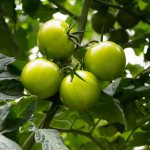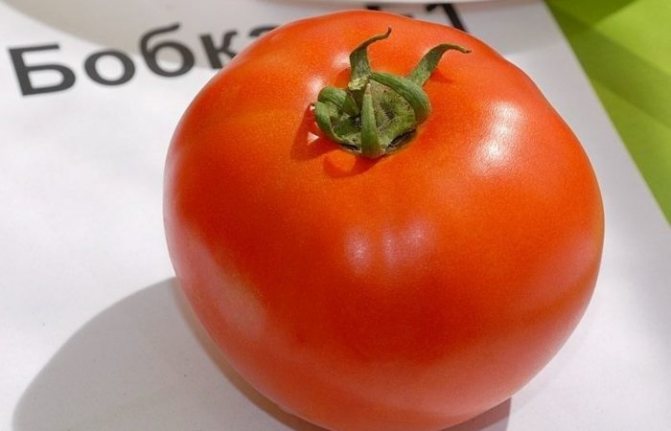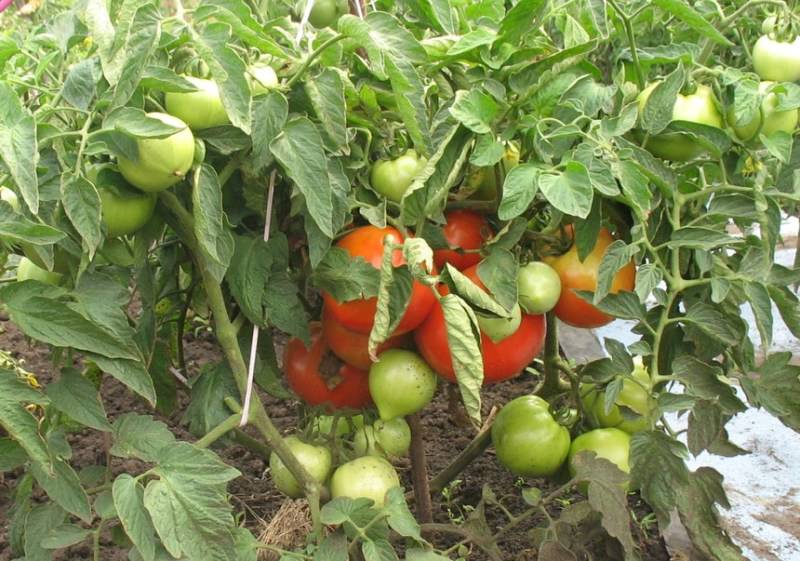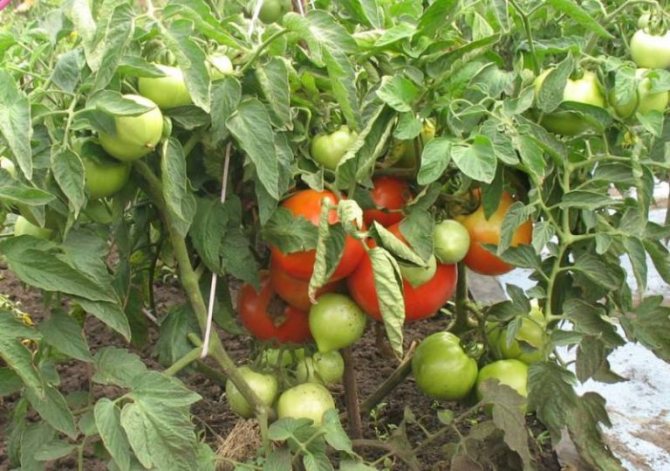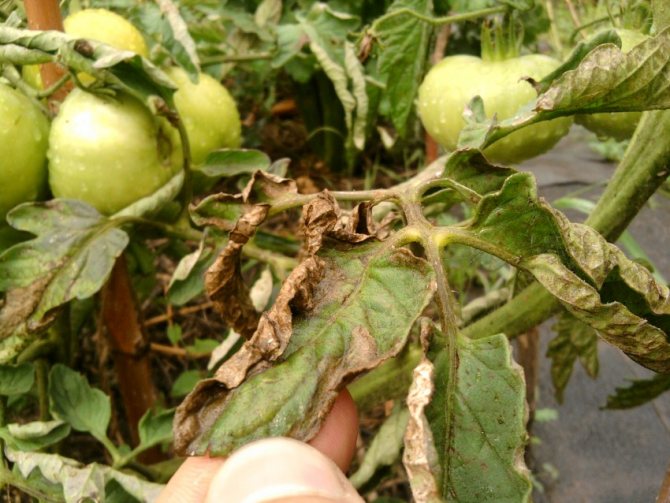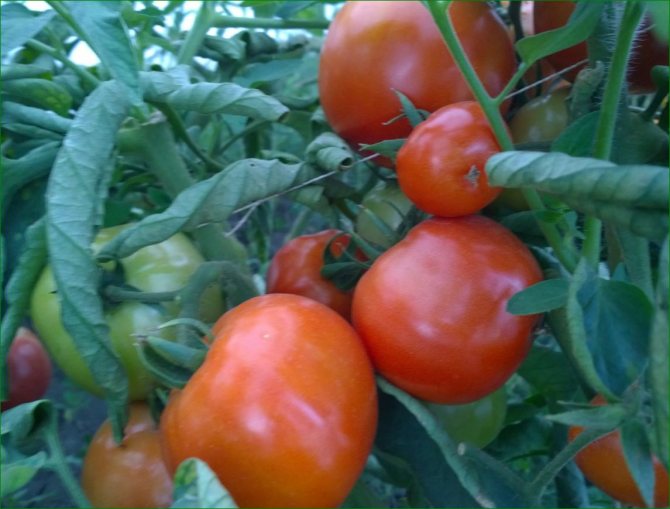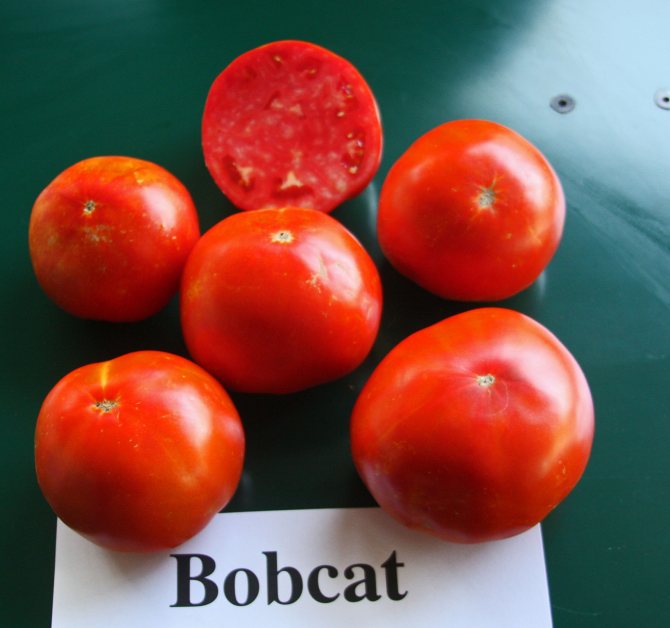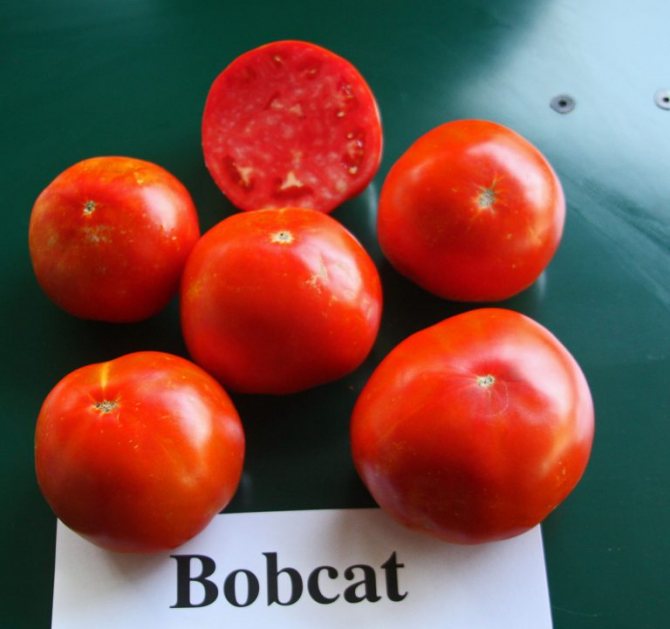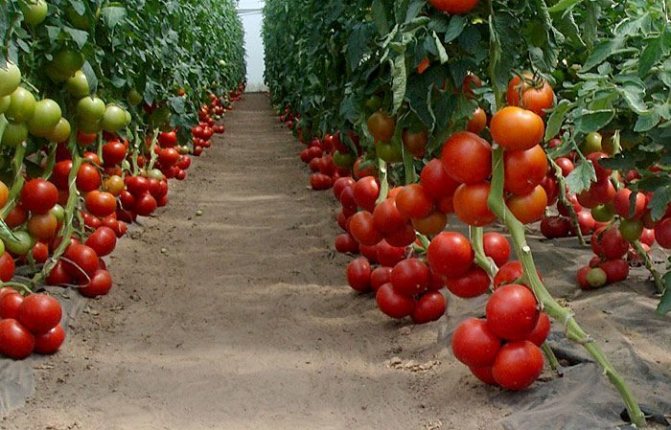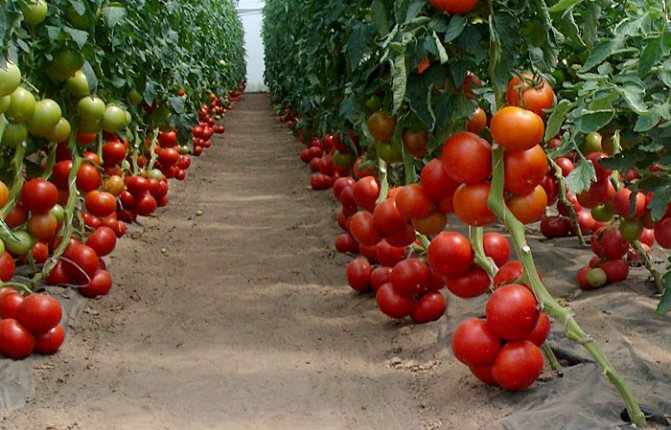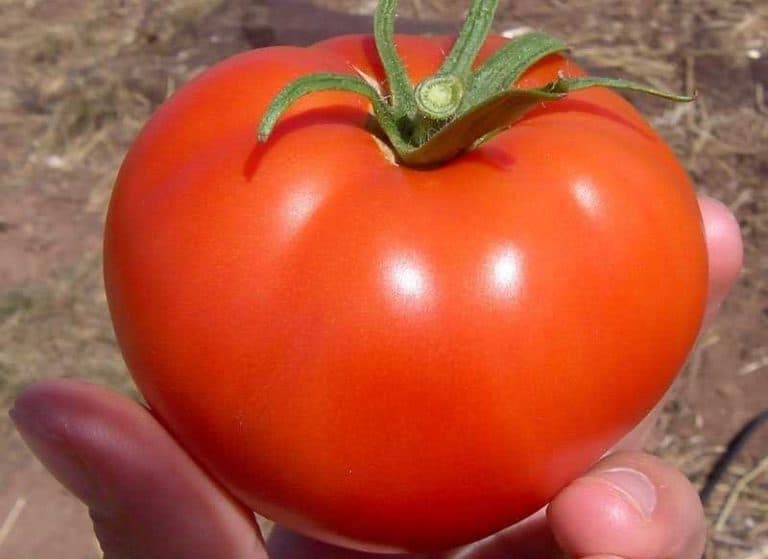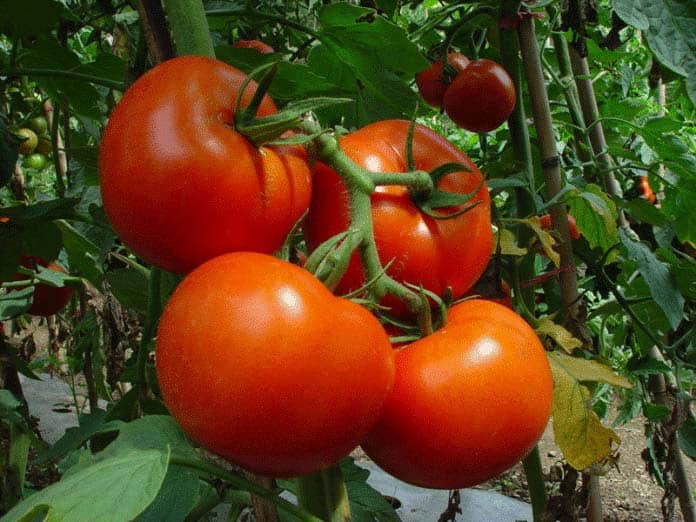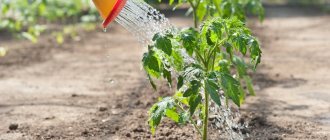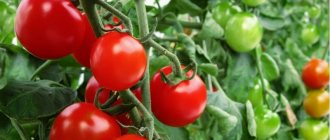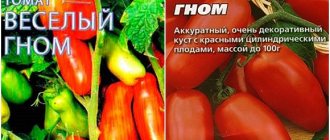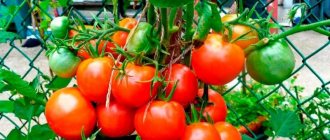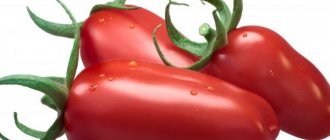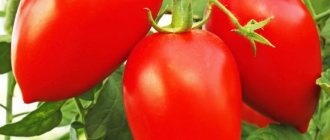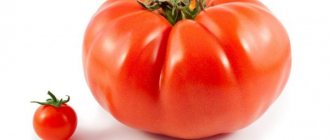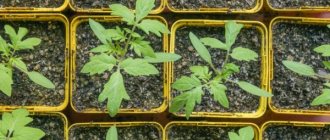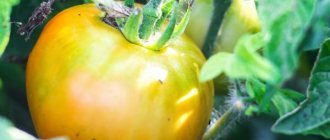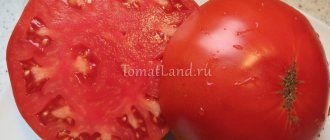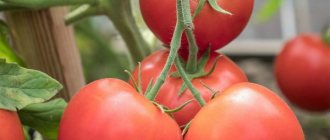Advantages and disadvantages
Many growers praise the variety, noting its advantages:
- high protective properties against diseases, pests;
- sweet and sour taste, provided with an ideal ratio of sugars and acids;
- resistance to external, mechanical damage, which allows you to transport fruits over long distances;
- good preservation in proper conditions (more than 30 days);
- ease of care, including in the formation of a growing bush;
- the compactness of the size of adult bushes gives them decorativeness, they are easy to plant in a permanent place of growth;
- good yield of tomato Bobcat F1, even with not very careful care.
The only and significant drawback is the long ripening period of the fruit. It is ideal for growing in the North Caucasus, Krasnodar. In areas with a less favorable climate, where summer lasts less than 3 months, it is worth growing the Bobkat tomato variety in greenhouse conditions, or simply choosing another one that ripens early.
The Bobkat tomato variety is an excellent choice for residents of the southern and middle regions of the country. It feels great outdoors in the south. In the middle lane, these tomatoes should be grown only in greenhouses. The culture is easy to care for. To get a good harvest, you just need to follow simple rules of care: moderate watering, pruning, top dressing, loosening, weeding.
Even with not very careful care, the variety gives a good harvest. This is a great start for a career as a grower without experience, as well as for those who do not like or cannot spend a long time in the garden or in the greenhouse caring for plants.
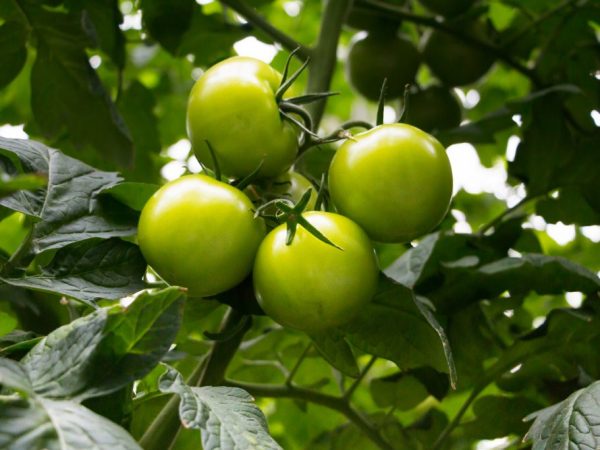
Tomatoes are easy to care for
Based on the characteristics of the variety, the following advantages of Bobcat tomatoes can be distinguished:
- resistance to major diseases and pests;
- yield above average and excellent taste;
- the bushes are unpretentious to care for;
- the best option for growing for sale: despite the large size and the presence of 4-5 chambers, tomatoes have few seeds and liquid inside, they are dense and fleshy.
Disadvantages: tomato - late, the harvest has to wait a long time. The variety is not suitable for all regions: in the northern regions it does not have time to ripen, the fruits are not large enough and juicy enough.
A month and a half after sowing, the seedlings will "drive out" the first flower cluster. Having noticed this, count 2 weeks in advance: it is at this time that the disembarkation will be made on an open area.
Overexposing plants in pots is not worth it, because the Bobkat tomato will partially lose its yield.
Important! Potatoes are considered to be the undesirable "predecessor" for a tomato. They try to "breed" these crops so that the soil is in the right tone for the bushes.
Make sure the soil is warmed up before planting. It should be well fertilized
... On the other hand, over-feeding will make the tomatoes look fat. It is also a good idea to disinfect the earth with copper
The planting scheme is simple: 4 - 5 plants are added to 1 m² of the plot, adhering to the "checkerboard" order. That is, the distance between the bushes should be no less than 0.5 m. The 40 cm interval usual for other varieties will not work (Bobkats have a branched rhizome). The planting process itself is simple:
- Wells are dug, which are immediately watered.
- While the moisture is absorbed, the seedlings with an earthen lump are carefully removed from the pots.
- Holding on to the lump, the seedling is moved to its permanent place. In the course of this work, the central stem is slightly deepened into a wet hole (a couple of centimeters will be enough) so that additional roots start up along it.
- The holes are carefully sprinkled with earth.
The indisputable advantages of the Bobkat F1 variety are the following:
- Large and dense fruits of a flat-round shape;
- The same fruit size;
- Pleasant taste, juiciness;
- Resistant to high temperatures and high humidity;
- Immunity to most diseases;
- No cracking when ripe (fruits do not burst);
- Preservation of appearance during long-term storage;
- Good transport tolerance.
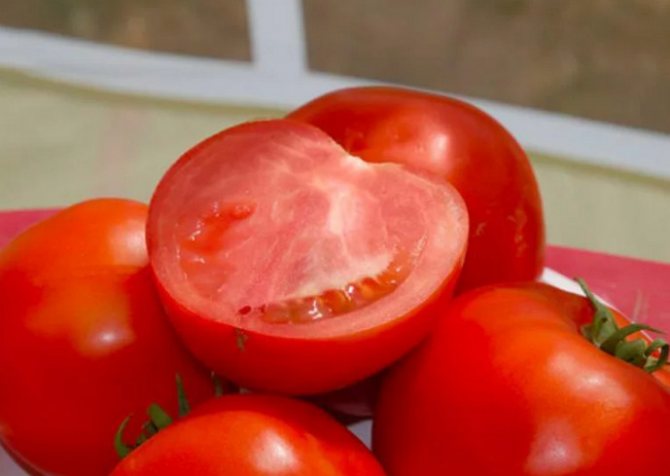

The disadvantages include.
- Thermophilicity;
- Late ripeness;
- Special requirements for soil moisture.
To calculate the timing of planting, you need to estimate the date of planting in open soil and subtract 65 days. At the same time, these terms will differ in different areas.
- In the south of the country, it is time to start seedlings from late February to mid-March;
- In the middle lane - from mid-March to early April;
- In the north - not earlier than April 1.
The Bobcat F1 hybrid is immune to many diseases, therefore, pre-treatment of seeds (heating, soaking, heating in the oven) is not required. The seeds from the bag are already ready for sowing.
The landing should be carried out according to the following rules.
- Seeds are planted at a distance of 1.5 cm into moistened clean soil to a depth of 1 cm;
- The holes covered with soil are moistened, covered with a film and placed in a warm place;
- If the soil dries out, it is periodically moistened with a spray;
- Highly moist soil is left temporarily uncovered;
- After 1.5-2 weeks, the film is removed.
IMPORTANT: In order to harden the plants, the container with the first shoots is taken out for several hours in fresh air (balcony, terrace or even street). The optimum air temperature is 15-20 degrees.
The time of planting seedlings in separate containers is determined by the appearance of 2 true leaves. But first you need to prepare the ground. It is disinfected with copper sulfate and enriched with fertilizers (ash, humus). But it is strictly forbidden to bring fresh manure into the ground.
Planting of seedlings is carried out in a checkerboard pattern, with 4-5 plants per 1 square meter.
Further care for the bushes is as follows:
- Tying the bush to a support set 10 cm away from it. This will help the stem to cope with the weight of the fruit;
- Removing 4 leaves per week improves yields;
- The number of abundant watering should not exceed 2 times a week;
- Preservation of moisture in the ground is ensured by a mound of straw or dry grass under the bush (mulching);
- It is necessary to get rid of stepchildren in a timely manner, as they prevent the absorption of nutrients by the bush;
- The formation of a bush in 2 trunks will provide a larger, albeit later, yield compared to bushes in 1 trunk;
- Top dressing of bushes leads to a significant increase in the yield of tomatoes;
- When growing the Bobkat F1 variety in a greenhouse, it is necessary to make frequent ventilation.
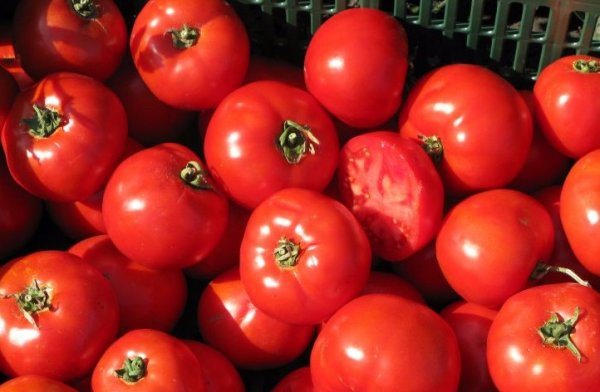

The hybrid is distinguished by a high resistance to most diseases (verticellosis, rot, spotting, fusarium, tobacco maize) and typical pests. However, you should not avoid preventive measures.
- Sufficient light and proper watering will eliminate powdery mildew;
- Regular inspection of the stems will help to notice the appearance of aphids that have spread from neighboring bushes in time;
- If the bushes are damaged by pests, you can use insecticides.
REFERENCE: Confidor will help to overcome the whitefly (the most common pest of tomatoes). Working solution - 1 ml per 10 liters of water.
Like any other variety, Bobkat has its pros and cons.
Read more: Peking cabbage - growing and care in the open field and greenhouse
| Benefits | disadvantages |
| Grown in open ground and greenhouses | Pinching required |
| Good yield, bears fruit before the onset of cold weather | The need to buy new seeds every year |
| Frost and heat resistant | Late maturation in the open field |
| The bush is low, does not require pinching | |
| Large fruits with excellent taste | |
| Storage duration | |
| Transportable | |
| Disease resistant |
Dutch Bobcat tomatoes are consumed both fresh and processed. The fruits are suitable for canning whole, and they do not burst. Tomato juice from Bobkat is used in dietary and baby food. An unpretentious variety is not afraid of diseases, pests and natural disasters. Bobkat tomatoes will give a good harvest with wonderful fruits even with little physical effort.
You can see other interesting varieties and hybrids of tomatoes with photos, descriptions and reviews in our
Tomato catalog
... Happy viewing.
If you have grown Bobcat tomatoes, please write whether you like them or not. What was the fruit taste and yield in your climatic conditions? How do you rate the resistance of this hybrid to diseases? Describe briefly what, in your opinion, are the advantages and disadvantages (pros and cons) of this tomato. If possible, attach a photo of the entire bush or individual fruits grown by you to the commentary. Thank you!
Your reviews about the Bobcat tomato and additions to the description will help many gardeners evaluate this hybrid more objectively and decide whether to plant it or not.
Growing tomato seedlings
There will be no particular trouble with sowing and the seedlings themselves: these activities are done according to the standard scheme for all tomatoes.
Check out other varieties of tomatoes such as Mikado Pink, Raspberry Giant, Katya, Maryina Roshcha, Shuttle, Black Prince, Pink Honey.
Before the start of planting, the timing is calculated: 65 days are taken from the planned date of disembarkation in open ground. The time to start seedlings will vary from region to region. If for the southern regions this will be a "window" between February 20 and March 15, then for the middle band the dates are shifted to March 15 – April 1. For the Urals and northern regions, the time from April 1 to April 15 is suitable.
Did you know? A pot with a tomato on the window was already a typical picture for our regions in the 19th century.
Tomato "Bobkat", as the reviews show, does not require additional seed treatment. Warming up, heating in the oven and even more "chemistry" are inappropriate here.
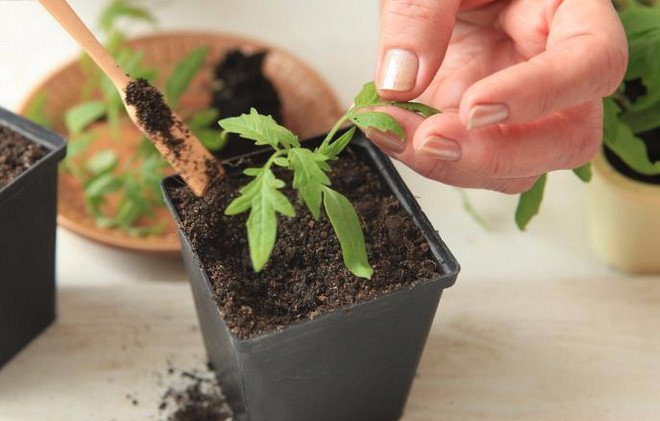

Let's start sowing:
- We fill the prepared containers (pots, cassettes or cups) with moistened clean soil.
- We make grooves up to 1 cm deep and about 3-4 cm apart between them.
- Between the seeds themselves, you need to adhere to a distance of 1.5 cm.If there is enough land for seedlings, you can take more. More rare sifting makes it possible to keep the seedlings in containers longer, without resorting to their "resettlement".
- Next, you need to fill the holes with soil.
- And in order to keep the desired humidity, cover the container on top with a film or glass, then placing it near the battery (so that it is constantly + 25-30 ° C).
Don't forget to check daily. Pay special attention to the soil: if it is highly moistened, temporarily remove the glass or film, letting the earth dry out. Noticing that the soil dries out a lot, moisten it with a spray, pouring with a direct stream is still early.
Important! Deep drying of the substrate is simply unacceptable.
Good lighting is a prerequisite. At first, daylight hours will not be enough, and a fluorescent lamp will come in handy here.
Seedlings will break through in 10 - 12 days, or even faster (it depends on the temperature).
The film is completely removed in 1.5–2 weeks. Until then, pay as much attention to the seedlings as possible.Examine them in the morning, preferably before sunrise, and also during the day: on a warm afternoon, the rays can even harm the seedlings. Any plant has a hardening period, and this quality can (and should) be developed. A container with already appeared seedlings can be taken out to the balcony or open a window if it is from + 15 to + 20 ° C outside.
After two or three weeks, the mature seedlings are fertilized. For such purposes, organic fertilizing is recommended, but purchased formulations based on humin or vermicompost will come in handy. At this stage, take half of the dose indicated on the package. Further fertilizers are applied at the same interval.
Any seedlings need a pick. Since "Bobkat" is a tomato and all its characteristics indicate the average height of the bush, one such operation will be enough.
Did you know? The first batch of tomato came to Russia in 1780. The "wise fruit" was even assigned a separate crew with security.
They do it when the seedlings are already strong enough (about two weeks after their appearance):
- We take a large pot with good drainage.
- We carefully dig in the seedling and separate it from the mass of the soil (try not to particularly catch the greens, it is better to work with an earthen lump).
- We shorten the main root by about 1/3, pinching off the unnecessary part.
- We add phosphate fertilizer to the hole.
- We move the seedling to a new place, gently pressing the root.
- We fall asleep the rhizome. In this case, the earth must be warmed up to at least + 20 ° C.
Learn more about growing other vegetables such as onions, rocumball, cherry tomatoes, gherkins, garlic, chili peppers, okra, zucchini.
The first time after transplantation, growth may stop. Because of this, many refuse to "stop" the spine. Yes, it is traumatic for the plant, but a healthy shoot will cope with such a shock.
Landing features
Good harvests require care. Our hybrids are quite unpretentious, but require constant attention from the owners.
Did you know? The fruit contains lycopene. It prevents the appearance of cancer cells and smooths out chronic inflammation.
Plants of this variety tolerate hot days well. True, it is better to maintain high soil moisture. Look at the weather - in the summer, two waterings per week will be enough. In case of high cloudiness, one abundant watering is enough for the same period.
Everyone knows about the benefits of mulching. A lot of materials are used for this, so let's talk about them in more detail. The beds are covered:
- Mown grass (the easiest method, which is suitable for both a greenhouse and open land). The grass settles down after a couple of days of drying (do not rush to lay it immediately after mowing).
- Compost.
- Universal straw (a layer of 10 cm will settle down to 5 over time, so you can put all 15 cm).
- Previously popular burlap will also retain moisture;
- A tight-fitting film will be a barrier against pests (it is interesting that for tomatoes it is better to take red material).
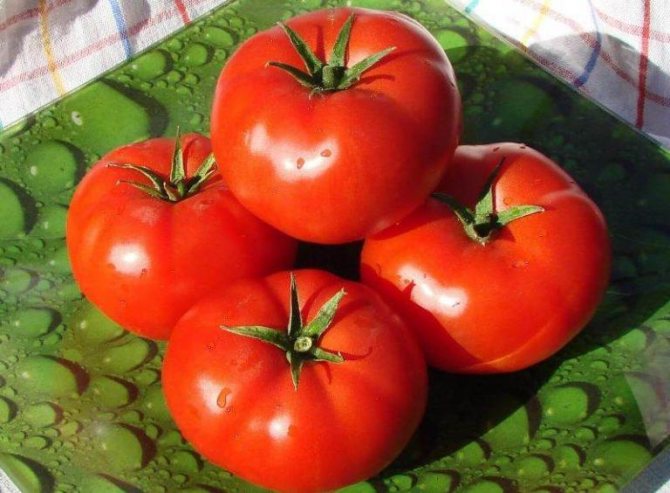

These are just a few types of mulch, although there are actually many more. However, these types of tomatoes are best suited for tomatoes.
Top dressing of bushes
It is better to do it regularly, every 2 weeks. If for some reason such a schedule is not kept, then the bushes are fed at least three times a season.
The fertilizers themselves also have their own requirements: for example, there should be more phosphorus with potassium in the solution than nitrogen. The presence of individual components is also important: plants need boron when they have already begun to bloom, while magnesium-based preparations will be appropriate at any time.
The same boron in the form of acid is mixed in a ratio of 1 g / 1 l of water, after which the green mass is sprayed.
Top dressing is best done in the afternoon.
Stepping
This manipulation can be carried out regularly, preventing stepchildren from growing up to 3-4 cm.
The shoots that have appeared under the brushes are removed first.If you tighten the plant, it can easily drop the flower along with the ovary.
There is no special trick here: grasping the stepson with two fingers, gently break them out, taking them to the side. Cut off abruptly is not worth it. If they are already large, you can use a knife.
To form a bush with three stems, you will have to leave the strongest shoot that has appeared above the second. For two stems, we act in a similar way, only we leave the process above the first brush.
Such procedures should not be dealt with in the heat, so as not to injure the bush once again. In rainy weather, on the contrary, you will have to remove not only the stepsons, but also the lower leaves.
Garter to support
The seedlings have taken root and started growing - it's time to tie up. A meter peg is enough, it is driven into a sufficient depth about ten centimeters from the stem.
Did you know? The largest tomato is considered to be 2.9 kg fruit, grown by a farmer in Wisconsin.
The bush can be "grabbed" to a horizontal trellis, it is even better in terms of yield. And it is more convenient for handling and cleaning.
As for other "agricultural techniques", such measures are reduced to hilling (3 times per season) and harvesting the weed when it appears.
Now you know what "Bobcat" is good for and how to get delicious weighty tomatoes. Record harvests!
Was this article helpful?
Thank you for your opinion!
Write in the comments which questions you have not received an answer to, we will definitely respond!
You can recommend the article to your friends!
You can recommend the article to your friends!
Yes
Not
72 times already helped
We recommend sowing seeds for seedlings 60-65 days before the intended planting in the ground. Seedling picking - at the stage of 2 true leaves. When transplanting seedlings to a permanent place, it is recommended for 1 sq. place 6 plants per meter of plot. Planting pattern: 50 x 40 cm.
Further care of plants consists of timely watering, removal of weeds, additional fertilizing with complex mineral fertilizers, preventive measures to protect tomatoes from diseases and pests.
Growing Bobkat tomatoes should take place through sowing seeds for seedlings. Sowing is carried out 55-60 days before planting in the ground.
It is important to select quality seeds for this. Purchased specimens are already prepared for sowing, treated with special means to protect the plant from the very beginning of its growth.
Growing seedlings
You cannot neglect the rules and technology of cultivation, because the normal development of the bush and yield depends on it.
- First, you need to calculate the timing: in warm regions, tomatoes are sown for seedlings in late February and early March. In the middle lane - in the first half of March, because warm weather appears here a little later. In the Urals, for example, sowing begins in the second half of April.
- It is necessary to purchase containers (peat pots can be used, with which the seedlings are then placed in the ground) and fill them with soil: sawdust, peat and humus (1: 3: 1).
- Pits or furrows are made in the ground, 2-2.5 cm deep and the seeds will be hindered there, falling asleep on top of the earth.
- The containers should be covered with glass or plastic wrap to retain moisture during seed germination.
- When shoots appear (5-7 days after sowing), the film or glass is removed.
- Place the containers in a warm (22-24 ℃), well-lit place, but not in direct sunlight. The best option is on the windowsill.
- Water as needed, this variety does not like a lot of moisture.
- On the 15-20th day after the seedling germination, it must be fertilized: Huminus, Biohumus are considered good purchased products: the dose prescribed in the instructions is divided, because the plants have not yet matured. You can use organic matter (humus diluted with water or chicken droppings).
- Tomatoes need picking after 2 weeks of growth. Shorten the main root by 1/3. This manipulation is carried out only once.
Read more: White Muscat grapes extra early: description of the variety, cultivation features
In early May, seedlings can already be planted in greenhouses (in open ground only at a temperature of 16-18 ℃). Before planting in open ground, you need to make sure that it is warmed up enough. Further, it is necessary to add ash or compos to the soil, for prevention, treat it with copper sulfate (disinfect). Wells are made in the ground and seedlings are placed there.
Description of the scheme:
- seedlings are planted in a row, making holes and watered immediately;
- the distance between the bushes should not be less than 40-50 cm, between the rows - about 0.5 m;
- the hole should be of optimal depth so that the root can fit freely there.
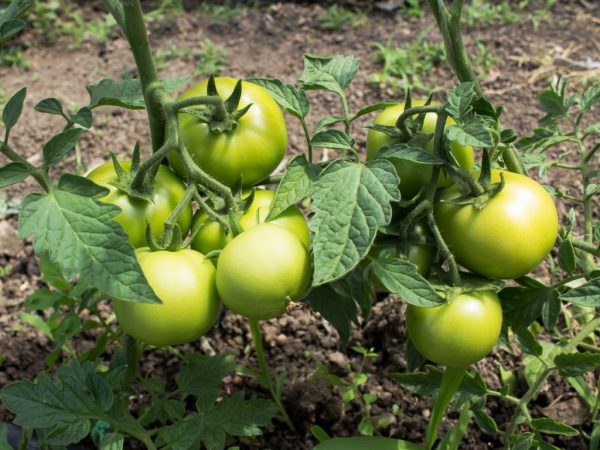

Plants are watered only with warm water.
The main thing is not to flood the soil, otherwise the root system will start to rot. Water the soil, not the bushes. The water temperature should be at room temperature. From cold, the plant will grow slower and begin to hurt.
Garter
The bushes are tied to trellises or special posts when they have reached a certain height (40-50 cm) so that the plant does not break.
I recommend forming one stem, so it will be more stable and energy will not be wasted on additional shoots. Periodically tear off the lower leaves and side shoots that have grown by 3-4 cm. the bush is leafy, it must be thinned not only from below, but also removed several leaves above.
Top dressing
According to the characteristics, tomato bushes should be fed every 3-4 weeks. Be sure to apply fertilizer during the flowering period, then before the beginning of fruiting, then - if necessary, in order to prolong this process.
To prepare the optimal mixture, for 10 liters of water you need to take superphosphate - 50 g, potassium chloride - 30 g and 15 g of ammonium nitrate.
It is good to spray the bushes once a month with a boron solution (1 g of powder per 1 liter of water), this repels insects and protects against diseases.
Mulching
To prevent the soil from overgrowing with weeds, it must be periodically loosened, the space between the bushes can be covered with straw, mowed grass or burlap. This will keep moisture in the soil longer and the weeds will bother you less.
The cultivation of the culture takes place in a seedling way. Bobcat tomato seeds should be purchased from specialized departments and stores.
When planting a Bobcat tomato for seedlings, you should know a few nuances:
- the need to prepare soil for seeds. Some growers buy ready-made mixture in stores. Those who use the land from the summer cottage - carry out, without fail, the procedure for disinfecting the soil, after which they are heated and combined with humus;
- seed boxes should be large enough. The seeds of the Bobkat tomato are buried 1.5 cm deep, keeping a distance of 3 cm between the seeds;
- after planting, the seeds are slightly sprinkled with earth and moisten the soil;
- boxes with seeds of a tomato hybrid Bobkat are covered with a film, creating the effect of a greenhouse, removed to a warm place before the seeds germinate;
- when the seeds have "hatched", the film is removed by placing boxes with seedlings in a well-lit place. Most often, this is a windowsill;
- after 2-3 days, the germinated seeds dive. At this stage, it is important to provide the seedlings with sufficient light and moderate watering. If there is a lack of natural light, put artificial lamps;
- by the end of spring, as a rule, the seedlings reach the required size for planting in a permanent place of growth. Before that, experienced gardeners advise hardening the seedlings so that they can quickly adapt to new conditions and grow into a healthy, strong bush.
- hardening begins with the fact that the seedlings are taken out to an open area, leaving it for 1-2 hours, the time is gradually increased to 24.
Tomato Bobcat: diseases and pests
Bobkat tomatoes are resistant to common tomato diseases such as Alternaria, apical rot, verticillosis, and fusarium. Compared to other varieties, it is less affected by late blight. The whitefly can harm the plant.
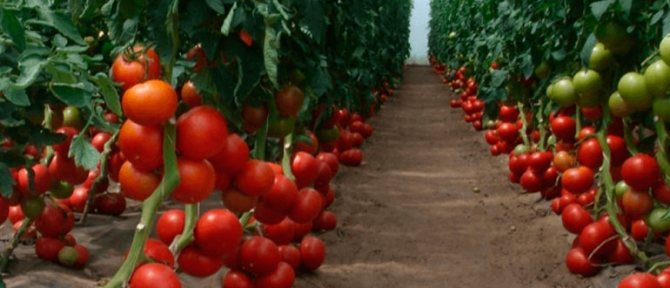

The Bobkat tomato variety has excellent immunity and is resistant to many diseases. Despite this, experienced vegetable growers recommend prevention. It consists in timely, moderate moistening of the soil, obligatory weeding, loosening, top dressing, providing a sufficient amount of light for the culture. The last factor is perhaps one of the most important.
Among the pests, it is worth highlighting the whitefly. It affects the greenery of the bush, which, with the further development of the lesion, can affect the harvest as a whole. Many summer residents prefer to treat affected plants with Confidor. 1 ml of the product dissolved in 10-12 liters of water is enough to treat up to 100 m2.
Collection and storage
Fruits are harvested in dry weather (wet ones immediately begin to rot and lie for only 2-3 days). Broken, damaged or cracked ones will not be stored for a long time, they must be immediately processed.
When the fruits of the hybrid ripen, they are filled with a bright scarlet hue. There are no green spots around the stalks. The shape of the tomatoes is round, slightly flattened. Senki of fruits are slightly ribbed. The skin is distinguished by a thin but durable glossy layer. Bobkat tomatoes are famous for the highest yield. About 8 kilograms of vegetables are obtained from one square meter in favorable conditions.
Tomatoes have a fleshy pulp of excellent taste, containing dry matter of about 6, 6 percent. The seed chambers in the inside of the tomato are in the range of 4 to 6.
Bobcat is a late-ripening hybrid. Ripening terms are slightly delayed in comparison with other varieties, so the Northern regions should take this fact into account and cultivate tomatoes in a greenhouse or greenhouse. The first ripe tomatoes are harvested 120 or more days after sowing the seeds. From the moment the seedlings appeared, it takes about two months.
In addition to pickling and pickling, tomatoes are excellent in their own juice, fresh fruits go to salads and for canapes or other sandwiches, pizza. Tomatoes are also prepared, mashed potatoes, thick pastes, tomato juices. Once the bobkat vegetables are plucked from the bushes, they are kept fresh under normal cool and dark conditions for about 30 or 45 days. Transportation is easily carried by Bobkat, the percentage of damage during long-distance transportation is small.
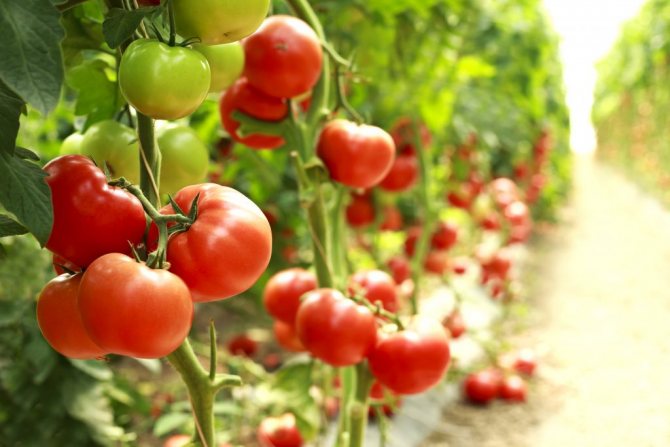

The significant advantages of this hybrid include its high yield. On average, it ranges from 4 to 6 kg per 1 sq. M. The entire period of fruiting, the plant pleases with large fruits of the same size.
Bobcat F1 was bred for planting in regions with hot climates. Therefore, the plant thrives on high temperatures.
- Growing tomatoes in the open field is excellent in the North Caucasus, in the Astrakhan region and the Krasnodar Territory;
- In the northern regions, planting in open soil will be difficult. Greenhouses are used for these areas;
- The variety can behave capriciously if the region is characterized by temperature extremes.
Pros and cons of the variety
It is advisable to grow "Bobkat" tomatoes both in private households and for sale. If you do not plan to use greenhouses, you can grow these plants provided that you live in a warm climate. To make a decision about planting tomatoes of this variety, it is necessary to evaluate their positive qualities and disadvantages.
Main advantages:
- Nice appearance.
- Medium size, easy to preserve.
- High resistance to disease.
- Long-term storage at low temperatures is possible.
- Transportability without deterioration of appearance.
Disadvantages:
- Difficulty growing in cold climates.
- It requires constant supervision, regular watering and top dressing.
Tomatoes of the "Bobkat" variety are distinguished by good germination, with proper care they can bring a large harvest. Tomatoes are characterized by resistance to pests and diseases.If you observe the temperature regime, regularly fertilize the soil and water the plants, you can guarantee the rapid ripening of the fruits.
Variety reviews
Many vegetable growers grow Bobcat tomatoes - reviews on the forum and gardening portals are mostly positive.
Read more: Powdery mildew on grapes and control measures
Svetlana, 45 years old, Krasnodar: “We have been growing Bobkat for several years in a row. Our climate is suitable. I like the sweet and sour taste of ripe fruits. We eat fresh with the whole family, make salads. Freshly squeezed tomato juice is especially to the taste of the whole family. Just a fairy tale! "
Tomato Bobcat video
Vladimir, 58 years old, Kaluga: “I love tomatoes, so sometimes I experiment with new varieties. Through the Internet, I learned about the Bobkat tomato variety from the reviews on the forum. Relying on them, I decided to try to grow tomatoes in my garden. In the open field - it did not work out to get a good yield, our summer is not long enough. This year I plan to grow it in a greenhouse. "
Victoria, 39 years old, Yekaterinburg: “We have excellent conditions for growing any vegetable crops, including tomatoes. I really love tomatoes, so I set aside a separate place for them on the site. I grow Bobcat tomatoes, the description of which met my expectations. They won me over with their amazing taste, as well as their ease of care and high yield - an excellent variety. "
Every gardener chooses the type of vegetable that he likes best.
Tomato Bobcat - the best of the undersized
Tomato Bobkat: characteristics, description of the variety
How do I form a stunted Bobcat tomato?
Bobcat F1 variety is the best option for growing. It is famous for its high yields and unpretentiousness in the process of growth and fruiting.
Tomatoes have a beautiful presentable appearance, which contributes to high sales, but the most important thing is its rich taste with a subtle sourness, which remains both fresh and processed.
Gardeners, who first tried to grow the Bobkat F1 variety, have no doubts in the further acquisition of the seeds of this particular tomato for their plots. In the reviews, farmers exclude the disadvantages of this hybrid, both in taste and in the convenience of growing, and note its positive features.
- Good germination and strong seedling;
- Productivity from one bush - at least 15-20 tomatoes;
- Ripe fruits of absolute uniform red color, regular and beautiful shape;
- Fleshy and juicy fruits, incredible taste;
- The weight of one tomato is really at least 180-200 g.
The summer residents also confirm the Bobkat's disease resistance: the tomato is really resistant to late blight and other possible diseases, but on condition that the lower leaves do not touch the ground.
To get a good harvest, gardeners in their reviews advise buying seeds only in company stores in quantities of 100 or more per pack.
So, for summer residents living in the southern regions of our country, the Bobcat F1 tomato is a godsend. Good harvest for vegetable growers - the hybrid is quite unpretentious.
If the conditions are right, farmers from the middle lane also use this variety for cultivation. Summer residents especially appreciate him for the fact that even in the absence of the possibility of frequent visits to the garden, he does not die and brings a good harvest.
Medium early, determinant, productive Dutch tomato hybrid. Recommended for growing in open ground, under temporary film shelters, in greenhouses.
The bush is powerful, well leafy, up to 70 cm high, a garter to the support and pinching is required. Seed producers recommend forming the plant into 1 stem. With this method of shaping, all stepchildren are completely removed (lateral shoots growing from the leaf axils). The leaf of this tomato is large, green to dark green. The inflorescence is simple.
- Elena
I am very pleased with this variety. Large, tasty fruits and very productive.
- Galina
I liked the bobcat tomato, the fruits were 600-700 g, did not hurt, this year I plant again, the tomato was stored for a long time, they were in greenhouses until October, I took it off when the frost began
- Oleg
Not a bad variety overall. Resistant to many ailments, except for stolbur. Responsive to feeding and pinching, does not like an excess of water (cracks).
- Galina
Until last year, I tied up and pinned all the tomatoes, in 2015 I tried a new (well-forgotten old) technology. She walked, bit her hands, but did not pinch, did not tie, after landing in open ground on June 5, she covered it with lutrasil on top, held it until the beginning of mass flowering (about July 5). During this time, the plants have gained a good mass, many shoots, abundant flowering. Watering, feeding. In August, the first fruits (berries?) Bobkat began to ripen - a very reliable hybrid. The fruits are beautiful, uniform, dense, tasty, well stored, there are many of them. A "workhorse" that will stretch your harvest and forgive many flaws in agricultural technology. Particularly fastidious, he may seem a little simple, but for "moderate lazy people" - this is just a godsend. So is the Marinda cucumber hybrid.
Yulia Samoilenko, Novosibirsk region
Ksenia Abramenko, Poltava
Alexander Yakovlevich
Lilia Ivanova, Voronezh
Characteristics of the variety
Tomato Bobcat F1 was bred by Dutch breeders in 2000 and quickly gained the attention of gardeners.
The type of bush is standard, determinant. The variety is recommended to grow in the open field (only temporarily under a film) and in greenhouses.
Bushes and fruits
According to the description, the variety has vigorous, resilient shrubs with many large bright green leaves.
The height of the bush is 70-80 cm, it needs a garter and pinching. The type of inflorescences is simple. Fruits of a round shape, slightly flattened, ribbed at the base, rich red color.
Weight from 200 to 350 g. They are distinguished by good density, glossy skin, of moderate thickness. The pulp has a slight sourness and is slightly grainy in structure.
():
Bobcat is a hybrid for commercial production. The fruits are leveled, do not become smaller in the ripening process. The hybrid has a powerful leaf apparatus, well covering the fruits from sunburn.
Yield
Tomatoes ripen in just 120-130 days from the date of sowing. The variety bears fruit abundantly, up to 3 months.
If you properly care for the bushes, apply top dressing on time, do prophylaxis and watering, then up to 10 kg of tomatoes can be harvested from m², but if the Bobkat variety is grown outdoors, then the yield will be less - 5-7 kg.
The quantity of the crop is influenced by the quality of the planting material. The variety is hybrid, so it is better to sow purchased proven seeds.
Disease and pest resistance
The variety is hybrid, so the breeders took care of the resistance of immunity to diseases common for tomatoes (verticillosis and fusarium) and pests, but prevention still does not hurt, because stability is influenced by climate, weather, sufficient moisture, soil quality.
Scope of the fruit
You can use tomatoes for home needs, as well as in industry. They can be stored for a long time and are suitable for transportation.
Fresh fruits are very tasty, they do not spread and remain dense for a long time when cut in a salad. In hot dishes, they retain their shape and original taste.
They are not very suitable for pickling and pickling for the winter due to their size (they are difficult to put in a jar). It is best to use them for making tomato paste, sauces, and juices.
Tomato Bobcat F1: description and characteristics from the manufacturer
A popular late ripening (up to 130 days from germination to fruiting) determinant (with limited growth) hybrid, recommended for film greenhouses and open ground. Ideal for salads and processing for tomato products.
Sowing seedlings in mid-late March. Pick in the phase of the first true leaf.Planting seedlings in greenhouses in early to mid-May at the age of 50-55 days. It is obligatory to tie the plants a few days after planting. Form into one stem, removing all the "stepchildren".
Fruits are round, weighing 90-226 g. Fruits are flat-round, ribbed, dense, perfect for processing into tomato products. Planting scheme 40x60 cm. The variety is resistant to verticillium and fusarium. Productivity 2.2-4.2 kg / m2.
Producers: Aelita, Gavrish, etc.
Sowing rules
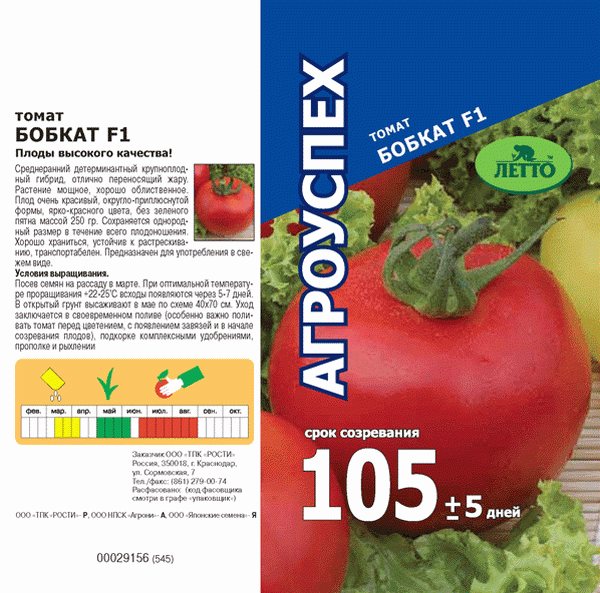

Tomato seeds Bobcat F1
In some sources, this hybrid is referred to as late-ripening tomatoes, noting that the first fruits ripen no earlier than 120-130 days after germination. This moment must be taken into account when calculating the timing of sowing seeds. Sowing is considered optimal. early or mid-March for growing in the open field.
Otherwise, the technology of sowing seeds and growing seedlings Bobkat F1 does not differ from other varieties. Before sowing, it is recommended to carry out preventive treatment of seeds with fungicides.
The origin of the tomato variety "Bobcat F1"
The homeland of tomatoes is South America, where their wild varieties are still found today. The following are brief summaries of the history of cultural development:
- Brought to Europe by the discoverers of America, the tomato has long been considered a type of ornamental plant, since the climatic conditions of European countries did not allow the fruit to ripen;
- Italians were the first to eat tomatoes. It was they who gave the name to the tomato ("golden apple") for the color of its fruit, which did not immediately turn red;
- The country that took first place in the world for the selection of vegetable seeds was Holland;
- The appearance of tomatoes in Holland dates back to the middle of the 16th century, but only from the second half of the 18th century did Dutch scientists begin to cross and select tomato varieties for their resistance to difficult climates;
- It is to the efforts of Dutch breeders that our farmers are indebted for the Bobcat F1 hybrid, which received official registration in Russia in 2008.
Fruit application
The fruits of this hybrid are versatile. Their use is varied.
- Ideal for fresh consumption;
- Suitable for whole-fruit canning;
- Good in the form of juices, ketchups, tomato paste.
Read more:
- Tomato Sprut F1: characteristics and description of the variety, cultivation technology
- Tomato Explosion: description and characteristics of the variety, yield and recommendations for growing
- Tomato Pink Giant characteristics and description of the variety yield recommendations for cultivation
- Tomato Mazarin - photos, reviews, description of the variety. Growing and caring for Mazarin tomatoes

